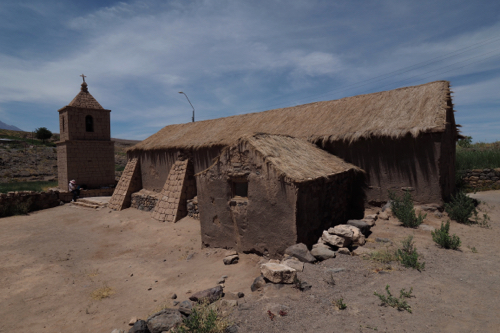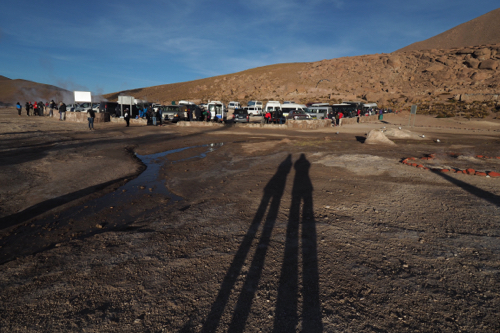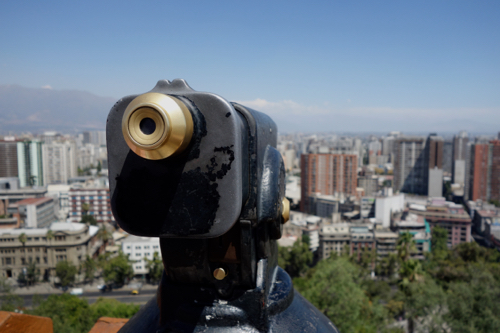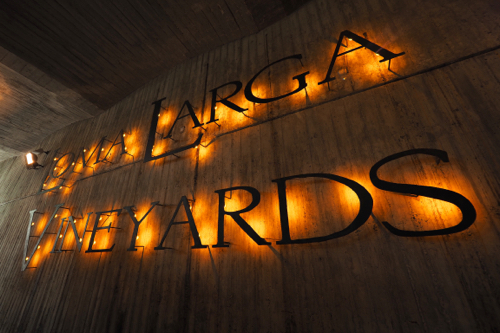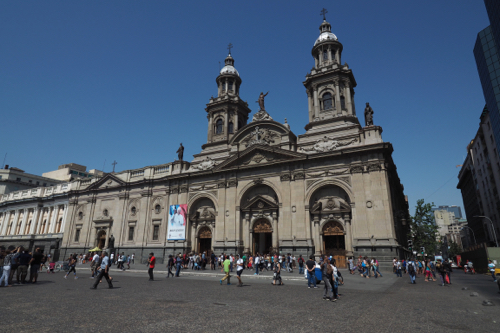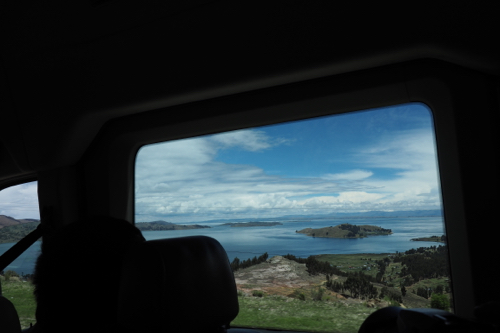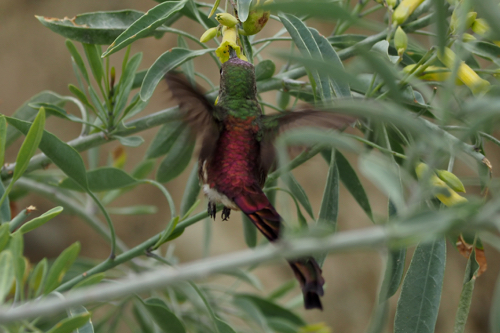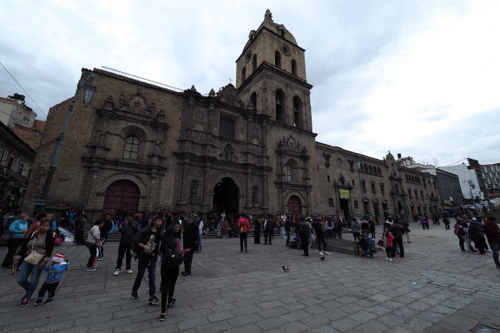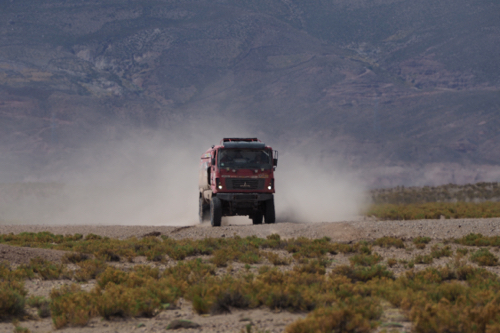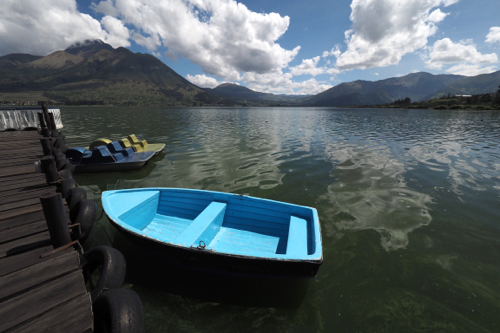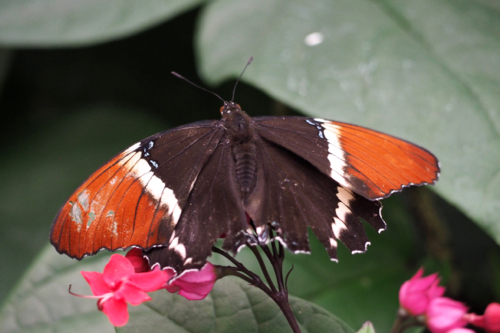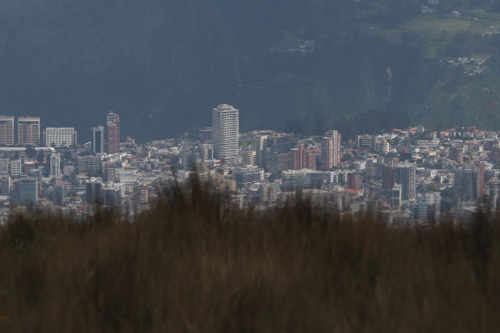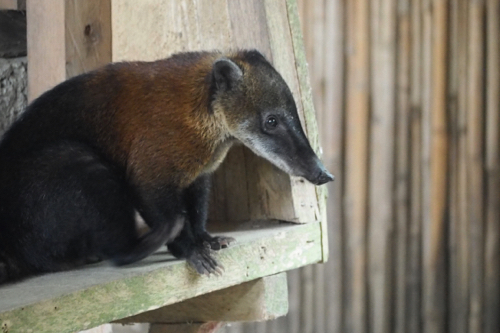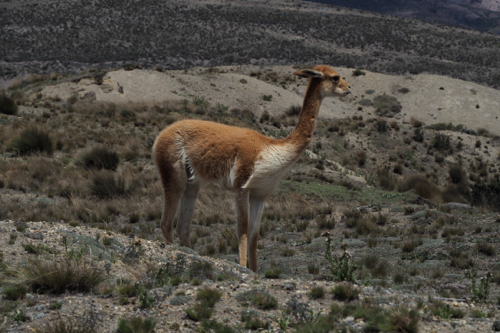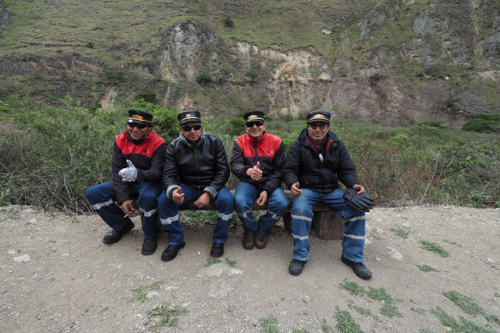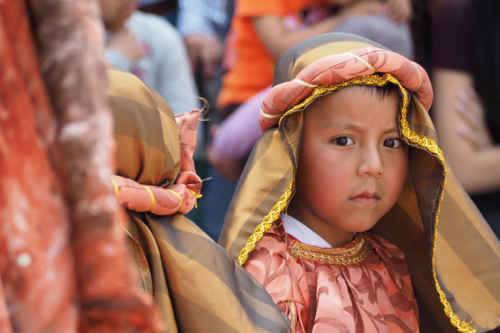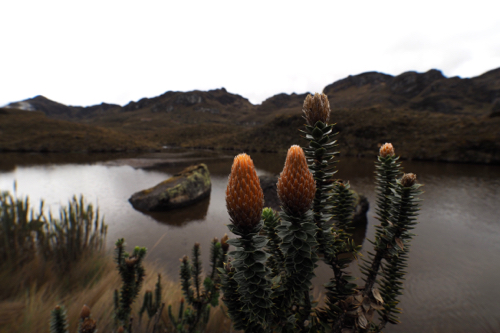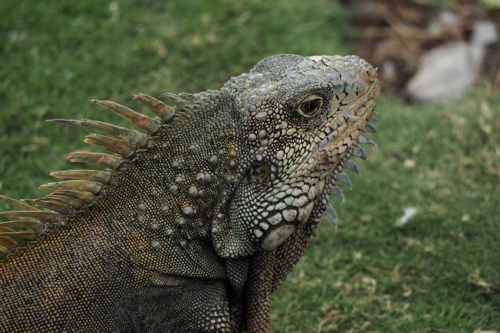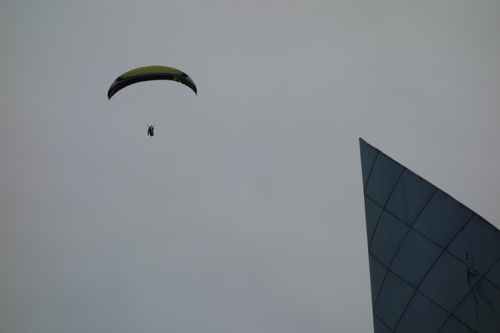
December 29, 2007. Guayaquil, Ecuador to Lima, Peru.
Our flight from Guayaquil to Lima in Peru was at 8:25am, so it was an early start at the airport.
Our hotel in Lima, The Best Western Urban Larco, was about 100 metres from the Larcomar Mall, the Miraflores shopping and restaurant area.
We actually had a view of the Pacific from our hotel room.
After settling in we then went for a wander around Larcomar Mall. The mall is perched right on the cliff edge overlooking the Pacific Ocean, a long way below.
Because of their height, the cliffs are a favourite spot for Parra Sailing over Miraflores. I was fascinated by the reflections of the flyers in the windows of the Marriott Hotel and Casino, that was just opposite the mall.
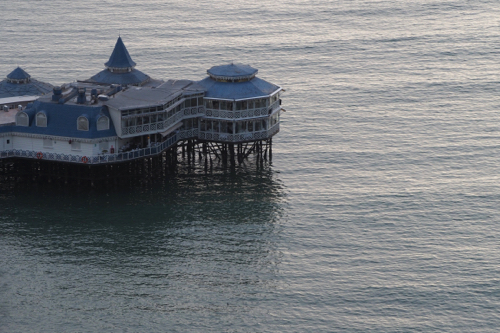
December 30, 2017. Lima, Peru.
We were in Lima for a few days and staying at a hotel that was a little more upmarket than we were used to – well it was New Year.
Lima is as huge city with over 10 million inhabitance – that’s one third of the population of Peru.
We felt it was just too large to explore by foot, so we hopped on the Lima City Tour. This was three hours, sitting on a bright yellow bus, being herded from site to site by our guide. It wasn’t the Hop-on-Hop-off sort but just a lot of driving around the city streets.
There were parts we couldn’t even get close to, like the main square, Plaza de Armas. It was closed due to the Pope’s visit, which wasn’t until January 18 – almost three weeks away.
Saint Francis Church, which is very close to the city centre, was built in the Baroque style in the late 1600s. The associated Catacombs were part of the the original cemetery in Lima. It is estimated that there are 75,000 bodies buried under the church.
Lima was founded by the Spanish in 1535 and is home to the National University of San Marco, the oldest educational institution in the New World.
Lima was always the principal city of Peru but became the official capital following the War of Independence which ran from 1811 to 1826. Peru claimed its independence in 1821 and secured it in 1824. This was following a successful campaign by José de san Martín and Simón Bolívor at the battle of Ayacucho.
We were to hear a lot more about these two gentlemen, as we continued our journey in South America.
With numb bums from the morning bus ride we headed out, on foot, to explore the area around our hotel.
There are walks along the Miraflores cliff top, through parks and along winding pathways.
The cliffs are 64 metres above the beach, so you really get the feeling of being high up.
It was dusk and there were many people enjoying the last of the day.
Lovers Park was very popular with cuddly couples. There were hints of Park Güell, Barcelona, in the tile-work.
Another fascinating aspect to the coastline was the surfers. There were waves full of them, all trying to get a ride on the rather small swell.
It did make a great snap at dusk.
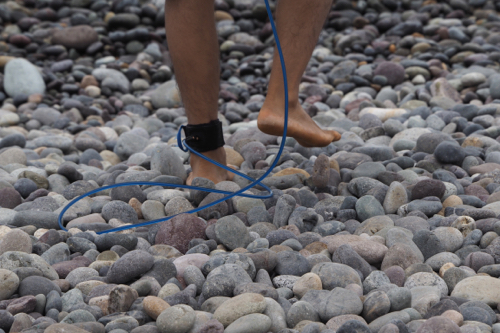
December 31, 2017. Lima, Peru.
New Years Eve in Lima was something of a mystery. We wanted to be in a large city, as we figured there would be more on offer.
This wasn’t necessarily the case.
After asking the hotel staff and wandering around the Larcomar Mall we settled on Mangos, a restaurant in the mall.
We ate there on our first night and it was great.
Mangos offered dinner and dancing. The dinner started at 9pm and the night went through until 5am.
I didn’t think we would last that long.
As the mall is built on the cliff tops, most of the restaurants have spectacular views. Unfortunately they are spoilt by the constant sea mist rolling in from the Pacific.
It was dark when we were in Mangos, so it didn’t really matter.
Our dinner wasn’t until late so we went for another cliff top walk in the afternoon. The sun did break through but there was still a sea mist.
Walking in the opposite direction to the previous day, we discovered the less attractive part of Miraflores.
Descending off the cliff top we got down to sea level. We then wandered along the pebble beach area to the pier and surfers at Makaha Beach. I felt sorry for the surf school pupils as they made their way awkwardly over the rocky foreshore. We are spoilt in Australia with our sandy beaches.
Down on the shoreline it was interesting to see the Larcomar Mall from a different perspective.
Mangos was decorated for New Year’s Eve with balloons, streamers, silly hats and horns.
We were seated on a table for four people but had no idea who the other two would be.
Then Oliver and Olivia turned up.
They were English, so at least we weren’t going to spend the rest of the night playing charades in an attempt to be understood.
They were a delightful, well travelled, couple who were in Lima for a friend’s wedding and were making a bit of a Peruvian holiday out of it.
Oliver was educated in the US and had friends around the world.
And they were all getting married.
They had ten wedding invitation in 2018 so more travel was on their agenda.
At midnight there were fireworks on the Jose Olaya, the headland facing Larcomar Mall.
It was a good evening and even though the restaurant was open until 5am, we were back at our hotel by 2.
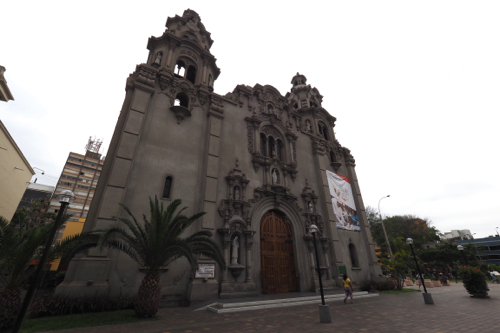
January 1, 2018. Lima, Peru.
It was a slow start to the morning even though we hadn’t had a particularly big New Year’s Eve.
Heading inland from the coast we wandered around the urban areas of Miraflores.
Being a public holiday the streets were crowded as were the public parks.
We visited the John F Kennedy and 7th of June Parks, then walked down the Diagonal back to the water.
Late in the day we went to the mall for an afternoon drink.
During our stay in Lima I discovered Curaka, a local Peruvian craft beer or Artisanal beer as it’s known locally.
And very nice it was too.
Great label with foil printing and excellent graphics. A real break from traditional beer labels.
Another find, unfortunately on our last night, was Barbarian 174 IPA. This was an India Pale Ale in the US style, hoppy with a lot of citrus overtones.

January 2, 2018. Lima, Peru.
The outing for the day was a visit to the Larco Museum (Museo Rafael Larco Herrera) This was a pre-Columbian Museum about 11 kilometres from our hotel in the district of Pueblo Libre – a taxi was needed.
The museum is in an 18th century colonial house and built on the site of a 7th century pre-Columbian pyramid.
It was a very comprehensive and well curated exhibition that covered the indigenous cultures, from before the Spaniards arrived.
There was a small section, dedicated to the post-Columbian era, concentrating on how the indigenous cultures adapted.
History has concentrated on the Incas as the dominant civilisation in the New World.
It’s true that the Incas were in power at the time of the conquistadors but there was so much more that preceded them.
For 400 years, from the 16th century to the start of the 20th century, mention was only made of the Incas in Peru. They only governed for the last 150 years, before the arrival of the Spanish. In fact there were cultures in Peru 10,000 years before that.
The museum was created in 1925 by Rafael Larco Herrera who bought a collection of some 600 artefacts from his brother-in-law, Alfredo Hoyle.
The arrival of the collection sparked the interest of his son, Rafael largo Hoyle who proceeded to become one of the pre eminent academics on pre-Inca civilisations.
He discovered and researched a number of cultures that pre dated the Incas. Among these were the Virú, Cupisnique, Moche and Salinar cultures.
As described in the exhibition: We live in the here and now or the ‘cult of life’ while ancient cultures, including Peruvian ones, practiced the ‘cult of the dead’.
In these times there were three divine worlds on earth.
The Sky, where the rains came from, the Land, which had to be worked and the Subterranean World, where growth came from and where the dead went, known as the Underworld.
They also worshipped various species from those words. Birds from the sky, animals on the land and serpents beneath it.
One of the interesting aspects of the exhibition was how symbolism changed from the pre-Columbian to post-Colombian eras.
Symbolic images on pottery and artefacts started with a feline attacking a deer, (the feline representing a god) then moved to man carrying the deer (man controlling the world) and ended with man carrying the feline (man ruling over the gods).
This empowerment of humans is known as the Extirpation of Idolatries.
Later in the post-Columbian period there was an attempt to amalgamate the European and indigenous cultures. This was done by introducing symbolism from the very Catholic Spanish Church. This is known as Syncretism.
Metals such a gold and silver were thought to contain supernatural powers. Gold represented the sun while silver the moon.
They were only allowed to be worn by the ruling class.
Rare gemstones and shells were also valued and only worn by the elite.
The entire exhibition was an eye opener. Not just the history but the diversity and craftsmanship that was evident in the exhibits.
Visitors even had access to the storage area of the museum. There were hundreds, in not thousands, of pottery artefacts stored away.
They claimed to be the only museum in Peru and one of only a few in the world that allowed this.
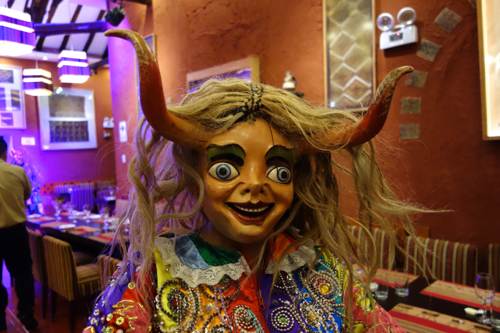
January 3, 2018. Lima to Cusco, Peru.
Today we were flying to Cusco to start the second part of our stay in Peru.
After much searching we found a local tour company that could provide a bespoke itinerary, covering the places we wanted to see.
After a delay leaving Lima and arriving in Cusco we got to our hotel, the Hotel Royal Inka 1.
It was a classic colonial building with balconies, verandas and internal courtyards.
It was only 100 metres to the main city square, Plaza de Armas or Armoury Square.
This was a vast square, in the Spanish style. Free of traffic with churches and colonnades on four sides.
After a wander around we ended up at Norton, a motor cycle themed pub. There I discovered another Peruvian Craft Beer, Sierra Andina Shaman IPA.
Part of the tour was a pick-up and drop-off service from the hotels. The guide taking us to our hotel in Cusco had an interesting take on Lake Titicaca, the famous high altitude lake south east of Cusco.
Lake Titicaca, is ‘tities’ for some and ‘caca’ for others. It all depends whether you’re from Bolivia or Peru.
I’m from Peru so we get the ‘tities’.
We ended up at Tunupa grill, bar and restaurant, all with a very Inca theme. I had the Guinea Pig and Thea had the Alpaca – we ate like a local that night.
The evening was over by 9:30, a big difference to Spain that doesn’t start until then.
Sometimes a piece of music gets stuck in your head and it just won’t go away.
The introduction to the Simon and Garfunkel hit “I’d Rather be a Hammer than a Nail” featured the Pan Flute – we heard it everywhere.
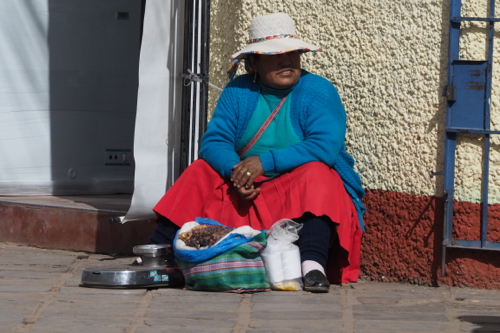
January 4, 2018. Cusco, Peru.
Today was set aside to explore Cusco before we headed off on our 13 day Peruvian tour.
We wandered around the church complex, which was just off the Plaza de Armas.
The Basilica Cathedral of Cusco definitely suffers from the, ‘Mine is bigger than yours’ syndrome.
Built over the site of an Inca monument, it’s huge.
The Spaniards destroyed these sites and used the materials to build their own edifices. They also superimposed their own Catholic meaning over Incan festivals.
Unfortunately no photos were allowed in the church.
Ironically in the centre of the Plaza de Armas is a fountain, featuring an Incan warrior. He is faced, on two sides, by churches.
I wonder if he is paying homage to them, or vice-versa.
We sat in the square for a while and were entertained by the number of hawkers who approached us.
They were selling sunglasses, jewellery, shoeshines, fruit salad, art, selfie sticks, umbrellas, ponchos, dolls on a key ring, hats, scarves, tours and restaurants.
All this was despite the fact that there were officials everywhere trying to stop them.
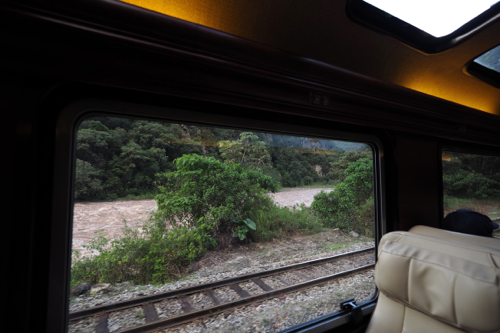
January 5, 2018. Cusco to Sacred Valley and Aguas Calientes, Peru.
Adriel was our guide to the Sacred Valley. He was an enthusiastic native of Ollantaytambo and a devout believer in the powers of the Incas.
He continually reminded us of this.
Our first stop was at Mirador Taray which overlooked the Sacred Valley of the Incas. This gave us a good opportunity to view, from above, the area we would be travelling through.
Next was the Pisaq Archaeological Park with its fine examples of Inca terraces.
The terraces were multifunctional, they offered protection in times of conflict, enabled agriculture in steep locations and helped stop erosion. Terracing was developed in South America by the Wari culture before 1000 AD. This was centuries before they were adopted by the Incas.
Terracing made more land available to produce food, which was important to feed the Inca Empire at that time.
The Incan Empire was the largest empire in pre-Columbian America and possibly the largest in the world in the early 16th century.
It has been estimated that there were 10 million Incas when the Spaniards arrived. A number that was soon reduced by war, destruction of their habitat and introduced disease.
Pisaq or Pisac was a mining town for gold, silver and brass. Today it is better known for its souvenirs, weekly markets and the Inca ruins that are nearby.
The bus stopped in Pisaq for a shopping opportunity.
There was a Canadian couple sitting in front of us on the bus. He was more interested in drinking beer than shopping. I agreed with him, but at 11:07am it was far too early for me, so I let him go and find a drink on his own.
We didn’t want to buy souvenirs either, so we went to the produce market. There is usually no pressure to buy there.
Driving along the Urubamba River, a tributary to the Amazon, we headed to Ollantaytambo. This is another archaeological site and as Adriel described it, “The icing on the cake.”
Ollantaytambo, located on the Patakancha River, was where the Incas made their last stand against the invading Spaniards. The Battle of Ollantaytambo took place in January 1537 and resulted in a win for the Incas.
The Incas were finally defeated in 1572.
It was a 1 hour 40 minute trip, most of it running along the Urubamba River.
The scenery was spectacular.
Inca Rail offer a very efficient service and even provides soft drinks and nibbles along the way.
We were staying at the Inti Punko Machu Picchu Hotel, which was right next to the railway station. It was only a short walk into the main part of Aguas Calientes.
This is a tourist town.
Catering to western tastes, there are any number of places to get an espresso, eat pizza and drink craft beer.
It’s very easy to get around as there are no cars. Everything is transported by hand, wheelbarrows or hand carts.
Being Australian we were intrigued with the number of Eucalyptus trees we had seen so far in South America.
They were first introduced into Uruguay by Antonio Lussich in 1896 and came to Peru in the first part of the 20th Century. They were initially planted to replace the native Andean trees that were disappearing as a result of European development.
The Eucalypts were used as a building material but later the oil was used for medicinal purposes. As the trees spread, their timber was used for firewood and in the charcoal industry.
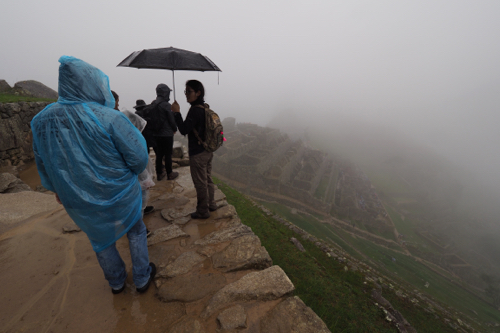
January 6, 2018. Aguas Calientes and Machu Picchu, Peru.
It was a 6am start for our visit to Machu Picchu. Nelly, our guide, said we needed to start early to miss the crowds.
Everyone else had the same idea.
When we got to the bus station there was a queue, stretching for 130 metres, of anxious people who’d also got up early.
It was about a twenty minute ride to the Inca Ruins of Machu Picchu. Climbing higher and higher into the clouds, around tight bends with treacherous precipices at ever turn.
Just after we arrived the clouds turned to rain.
Tourists are very silly people. There were thousands of us visiting Machu Picchu, in the rain.
Not just drizzle but at times, heavy rain.
The poncho sellers were making a killing.
We finished our morning guided tour with Nelly but opted out of staying for the afternoon.
We were soaked to the skin and she didn’t think the weather would improve.
Machu Picchu is situated 2,430 metres above sea level. This Incan citadel was built in approximately 1450 but abandoned a century later, at the time of the Spanish conquest.
Unearthed and revealed to the western world by Hiram Bingham in 1911, it was made a UNESCO World Heritage Site in 1983.
In 2007 it was made one of the New Seven Wonders of the World, along with the Great Pyramid of Giza in Egypt, the Great Wall of China, Petra in Jordan, the Colosseum in Rome, Chichen Itza in Mexico, the Taj Mahal in India and Christ the Redeemer in Brazil.
Once we returned to our hotel the main task was to change our clothes and get the wet ones dry.
Fortunately there was a small portable radiator in the room, so we managed to hang everything around this.
Our room looked like a Chinese laundry.
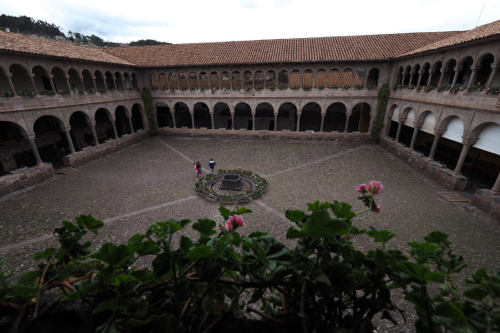
January 7, 2018. Aguas Calientes to Ollantaytambo and Cusco, Peru.
Today we were returning by train, back to Ollantaytambo and then by bus to Cusco.
This time we were on Peru Rail rather than Inca Rail. This was a win as it was much easier to get from our hotel to the Peru Rail station.
When we arrived on Inca Rail it was a struggle, as the platform was at the bottom of a long, steep set of stairs. Fortunately one of the train passengers took pity on us and effortlessly carried Thea’s bag to the top.
A lot of the railway line runs besides the Urubamba River. This is a raging torrent that descends from the Andes, flowing north and eventually joining the Amazon near the border of Peru and Columbia.
This water is destined to flow into the Atlantic Ocean in Brazil.
The drive back to Cusco was along the Sacred Valley again. The clouds were still blanketing the mountains.
There seemed to be a lot of old VW Kombi Vans and Beetles still on the road in South America. This isn’t that surprising, as the last ‘old style’ Beetle rolled of the production line in Mexico in 2003. While in Brazil, production of the Kombi, or Type 2 Microbus, only stopped in 2013.
We turned off at Urumbamba and climbed to Chinchero at 3,750 metres.
The closer we got to Cusco the more ‘Chicken Buses’ slowed down the traffic. (A Chicken Bus is local transport that carries everything, including livestock)
After arriving back in Cusco we went looking for lunch for Thea and a coffee for me.
We found Jack’s Café on Google. Purportedly owned by an Australian, it had Avocado on Toast and a ‘long black’
The avocado was fine but the long black was an Americano and the staff didn’t know the difference.
We were told that, being a Sunday, all the museums were closed, then we discovered Museo Quechua. It wasn’t really a museum but a shop.
However just up the road we found the Convent of Santo Domingo – Qorikancha. This was a real museum and it was bursting at the seams.
No wonder all the other ones were closed.
The museum is a combination of an old Inca temple and the St Dominic Priory of Cusco. Founded in 1534, it was the first Dominican Priory in Peru.
Qorikancha also known as Coricancha was the centrepiece of a vast astronomical observatory. The Convent of Santo Domingo is built over the top and you can still see parts of the old structure.
The Spanish who first entered Cuzco tell of the temple and describe it as, ‘beyond belief’ There were reportedly 4,000 priests, working around the clock, at the site. The carved granite walls were said too be covered in 700 sheets of pure gold, each weighing 2 kilograms.
The gold was very quickly acquired by the Spanish conquistador, Francisco Pizzaro, who melted it down and then built the church.
St Dominic Priory of Cusco, founded in 1534, was the first Dominican Priory in Peru.
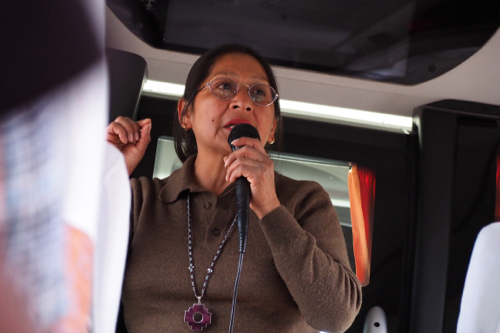
January 8, 2018. Cusco to Puno, Peru.
It was 395 km from Cusco to Puno, in a large, bright green tourist bus.
There were four scheduled stops along the way, plus lunch.
Marita was our bi-lingual tour guide, however I think she may have a few more languages up her sleeve.
There were about 30 people in the group and we were herded like a flock of Llamas. Marita was our teacher and we were her unruly students on a school excursion.
She delivered her commentary with passion and an obvious belief in the spirituality of the Andean cultures.
Mysticism has been a constant theme in Peru. A belief not in the here and now but in a world that goes beyond an earthly realm.
The Church of St Peter and St Paul, at Andahuaylillas, was our first stop. Due to it’s richly decorated Baroque style, it is referred to as the ‘American Sistine Chapel’
The paintings, murals and sculpture were all done by locally trained artists.
No photos were allowed but we were given a CD containing some shots.
How good they are will remain a mystery until we find a reader and download them.
The CD was produced by the Society of Jesus in Cusco and the Route of the Andean Baroque.
They are involved in the restoration of churches along the Andean tourist trail. The money that is raised in tourism goes towards social work amongst the local people.
Just next to the Church was the Alien Mummy Museum.
This was a very questionable exhibit that believes they have the mummified body of an alien.
Yet another example of their spirituality.
Next was a stop at the Inca archeological site of Raqchi, also known as the Temple of Wiracocha. It was believed to have been built sometime during the 12th or 13th centuries.
Our last stop was the tiny Pukara Museum, unfortunately no snaps were allowed, yet again.
Pukara was a pre-Incan culture north of Lake Titicaca. It dominated the lake region but was most active from 500 BC to 300 AD. As well as hunting, agriculture and fishing they were artisans. creating finely made pottery, textiles and ceramics.
Some of this work was on display in the museum.
It didn’t take long to see this very small museum, so there was time for a coffee. Fortunately there was a reasonable espresso available, just up the road.
Their tiny automatic machine was working overtime.
After about 10 hours on the road we reached Puno. Positioned on the banks of Lake Titicaca, at an altitude of 3,827 metres, it is one of the world’s highest cities.
It was founded in 1668 by the Viceroy Count Lemos and named ‘San Carlos de Puno’ in honour of King Charles II of Spain.

January 9, 2018. Puno and Lake Titicaca, Peru.
Yet another early start, this time to explore Lake Titicaca.
This alpine lake borders both Bolivia and Peru and is the largest lake in South America and the world’s highest navigable lake.
Five major river systems feed Lake Titicaca, with over twenty smaller streams also flowing into it.
Our guide today was Bloody. As he said, his parents made it up but didn’t know what they were doing.
The Uros floating islands, made from a type of papyrus, were our first stop. There is one family per island, consisting of a number of different generations.
They are a pre-Inca culture and speak their own language, Quechua, plus an Inca derivative, Aymara, and Spanish.
There are 97 of these islands holding 1,200 people. They have an overall leader who is the the president, plus every island has a chief.
The island we visited had the only female chief.
The Uros tribe developed their island communities to defend themselves from rival tribes.
We were given a demonstration of how the islands are created and shown how they live.
There was an opportunity to buy at the end.
We were then taken by the island’s reed boat to another island where there was a chance to buy snacks and use the WC.
This was followed by a two hour boat ride across Lake Titicaca to Taquile Island.
Due to its high quality textiles (knitting and weaving) it has become a UNESCO World Heritage Site.
On Taquile the women weave while the men knit.
This community operates on three principles. Don’t lie, don’t steal and don’t be lazy.
The lake is rich in fish, with Llamas and Vucuna grazing on the shores. Various civilisations have been in the area for over 3,000 years.
By the time we arrived at the island the rain had as well.
After a very steep climb we reached the village perched on the summit. As was to be expected the views from the top were spectacular.
The local woven and knitted products were all for sale in the craft market.
From there we walked around the island to the other side. This was on a good stone path and nowhere near as steep as the the one we climbed up on.
Again the views of Lake Titicaca were amazing.
Lunch was in a local restaurant, that seem to be suspended on the cliff face.
There were about 25 in the group and we all sat at one long table overlooking the lake.
The rain had vanished and we could enjoy the bright blue sky and lake while eating our lunch.
After lunch the family who ran the restaurant put on a show. They demonstrated making soap and then proved how well it worked by washing some dirty sheep’s wool.
Then there was a bit of singing and dancing before we descended to the wharf below.
The boat ride back to Puno was much brighter than the ride there.
We were dropped off in the town square, Plaza de Armas de Puno, and then wandered back to the hotel.
It had been another long day.

